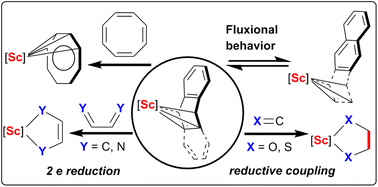Diversified two-electron reduction for trivalent scandium complexes with arene ligands†
Abstract
Reduced arene complexes of rare-earth metals are of great interest and importance because of their unique reactivity mimicking low-valence rare-earth metal species. Here, we present the synthesis and structural characterization of a series of reduced naphthalene or anthracene complexes of mononuclear scandium with mixed C5Me5 (Cp*) and amidinate ligands. Among them, the reduced anthracene complexes of mononuclear scandium have been found for the first time to undergo a rapid inter-ring rearrangement. Significantly, a reduced anthracene complex with a scandium center attached to the terminal six-membered ring of anthracene was synthesized by modulating the substituents on the amidinate ligand. The diversified two-electron redox reactions of the reduced naphthalene complex of mononuclear scandium toward cyclooctatetraene (COT), dibenzo[a,e]cyclooctene, benzophenone, 1,4-diazabutadiene (DAD), isothiocyanate, and selenium were examined. The scope of two-electron redox reactions via the trivalent scandium complex with the mixed Cp*/amidinate/arene ligand system is significantly expanded, and thus, these results remedy the shortcomings where it is difficult for rare-earth complexes to undergo the two-electron redox process.



 Please wait while we load your content...
Please wait while we load your content...